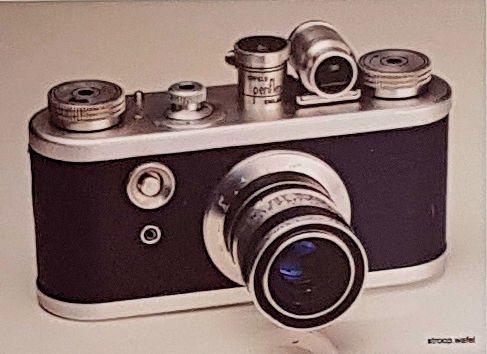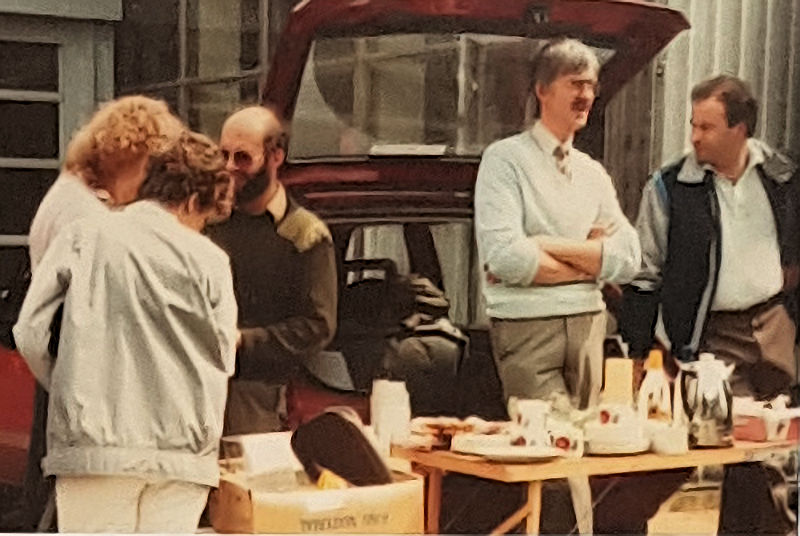Timeline: 1950 – 1962
1950s — The wider picture

The 1950s saw increasing prosperity in Banbury and the country in general. It was famously summarised by Harold Macmillan in 1957 as “most of our people have never had it so good.” The British Journal Photographic Almanac for that year listed a far wider range of cameras than in 1946. Many of these were of British manufacture, some of high quality and others of somewhat eccentric design. They were not yet exposed to competition from Germany and Japan, as there were still severe restrictions on the importation of photographic equipment. A photo of the club in action shows an elderly camera which took glass plates rather than film.
Periflex Camera

This British camera took 35 mm film and had an unusual focusing system. The photographer looked down into a periscope to focus the lens, but then switched to a separate viewfinder to compose the shot. When the shutter release was pressed, the periscope moved up out of the light path and the focal plane shutter opened to make the exposure. The periscope descended again when the film was wound on. This design was not competitive when import restrictions were finally lifted, on German and other European cameras in November 1959, and on Japanese cameras from 1st January 1962.
1953 — The Coronation and Television
The live televising of the coronation Queen Elizabeth II on the BBC was a groundbreaking event, attracting a huge audience and boosting both sales and rental of TV sets. The launch of ITV in 1955, at first in London and soon spreading to all areas, added to the demand. It was surely responsible for a fall in cinema attendances and for the decline in audiences for other evening activities, such as the public shows which the camera club put on between 1965 and 1973. The Banbury Guardian records an audience of 300 for one these club shows in 1967, with tickets costing 2/- (10p).
1960s
Colour
While television remained in black and white until colour was launched on BBC 2 in 1967, colour film, and particularly 35mm colour slides for projection, became very popular with amateur photographers. By today’s standards, and compared with black and white films of the time, the films were very slow, with the classic Kodachrome rated at just 10 ASA (ISO). Between 1963 and 1977, the club ran an Open Colour Cup Competition open to all photographers in the area, but costs eventually became prohibitive and the competition ceased.
1970s and 1980s
Finances

The 1970s did not open well for the camera club. The membership in 1971/2 had fallen to 22 and the treasurer reported to the annual general meeting that it had been a “disastrous year financially”. Nevertheless, the meeting resolved not to increase the annual subscription, which at that stage stood at £1.75, having been raised from £1.50 the previous year. Raising sufficient funds remained an issue and, as a successor to the jumble sales of the 1950s, a car boot sale became a regular event into the 1990s.
Outings and Excursions
Outdoor meetings and excursions to places of photographic interest had always been part of the programme, with the very first event in 1946 having been a photographic ramble. Subsequent events seem to have been less energetic. Venues included, for example, Hook Norton Brewery, Cakebreads Monumental Masons, General Foods and Steele’s Carpet Factory — although “it was a rather disappointing evening” in June 1986 when the person to have shown members round forgot the appointment. The first photograph seems to have been taken at a swimming pool around 1960, while the second shows members on a visit to Hornton Forge in 1986. There is a marked difference in the equipment being used, reflecting the huge developments in that period.
Loss of 51 The Green and its facilities
The late 1970s and early 1980s were a difficult period. The committee and annual general meeting minutes of the period record continual worries about decreasing membership, low attendance at meetings and the need to raise money. There was a suggestion from the then chairman to introduce grades of membership called Third, Second and First Class. Everyone was to start as Third Class and to progress (or not!) through successful completion of various projects. It’s not at all obvious that this would have been a solution to the membership issues.
The club had remained at 51 The Green since 1952, although by the 1980s it had lost the darkroom facility and simply had one meeting room once a week. As Isabel Smith says in her club history: “We hung on to that room until 1984, the great benefit being that we only paid for the lighting (the heating was just what was left over from the daytime heating so it was sometimes pretty cold), and sometimes not even that. So it was with considerable dismay that we learned that the building was being sold and that we would have to find somewhere else.” In the event, the club moved to the then Banbury School, where it remained until 2000. Isabel and other members of those days deserve enormous credit for carrying the club through some tricky times, when it might well have folded.
